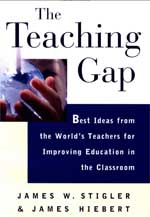
As I was considering what to write for this issue a couple weeks ago, I thought about zeroing in on the anniversary of No Child Left Behind. Good and current topic! But after the President’s State of the Union address I felt obligated to vent my thoughts regarding math and science education, actually education in total.
Most of you who have been reading Eye2theWorld’s issues know I’ve been consistent in my belief that our educational system does not need reform. It needs transformation! While I hold dearly to that viewpoint, I am also realistic in knowing that big things must start with small packages, a step at a time. And so, even though I may be impatient, I think change has to begin. We can’t wait for nirvana.
President Bush opened to door for change when he announced requests for dollars to hire additional qualified math and science teachers. Great! But that’s only part of the solution.
I am going to stop my ranting at this point to describe a book, The Teaching Gap: Best Ideas from the World’s Teachers for Improving Education in the Classroom by James W. Stigler and James Hiebert, (1999). Free Press, 1999. Hardcover, 224pp, $23.00. ISBN: 0-684-85274-8. In it lies the real basis of our educational problem, the culture both within education and education being part of the larger culture. I urge you to read this review and then to turn to Amazon and buy a copy of the book. Whether you’re a professional educator or not, I think you’ll find, as I did, needs that transcend hiring more qualified teachers if real change and ultimate transformation is to occur.
The authors describe their participation in the Third International Mathematics, and Science Study (TIMSS). One portion of the study was comparison of mathematics teaching methods at the eighth grade level in Germany, Japan, and the U.S. Several classes in each country were videotaped for comparison. Methods within each country varied very little. There were more differences between countries than within each country.
American teachers were good at teaching with their own methods, but there were not any programs in place to improve those methods. The other countries were found to improve their methods on a continuing basis, thus resulting in “the teaching gap” advantage.
American students were presented less challenging concepts, but in a less coherent way, and struggled more to reach understanding. In Japan, the teacher and students share the mathematical problems and methods, thus, in essence, exploring for the best methods. In Germany and the U.S. the teachers led the students through their more standard methods.
For instance, in the U.S. mathematics competency is considered to be a mastery of procedures needed to solve problems. In Japan, they perceive that mathematics is a study of relationships of concepts, facts, and solving procedures. American teachers used overhead illustrations a lot to lead students through detailed procedures in modular chunks. Japanese teachers presented more complex problems and helped their students understand and represent the problem. Subsequently they then took a monitoring role with discussion of alternate methods elicited from the students, presenting their own if needed. They preferred using a chalkboard to demonstrate aspects of a problem and connections between them.
The authors conclude that there are cultural scripts that teachers are using and that results will only be as good as the script allows and ” To improve teaching over the long run, we must improve the script.”
Here’s the book. Click on the title or cover to get more reviews and purchasing info.
 The Teaching Gap: Best Ideas from the World’s Teachers for Improving Education in the Classroom by James W. Stigler and James Hiebert
The Teaching Gap: Best Ideas from the World’s Teachers for Improving Education in the Classroom by James W. Stigler and James Hiebert
From the back cover:
“Stigler and Hiebert’s comparative analysis of Japanese, German, and U.S. teaching advises us to make schools places where teachers have the time and support to systematically study and improve upon their daily work. How sensible!”
Sandra Feldman, President, American Federation of Teachers
There is also a web site devoted to The Teaching Gap. It contains the text of the first chapter and a discussion forum where readers can interact, and other pertinent information.
